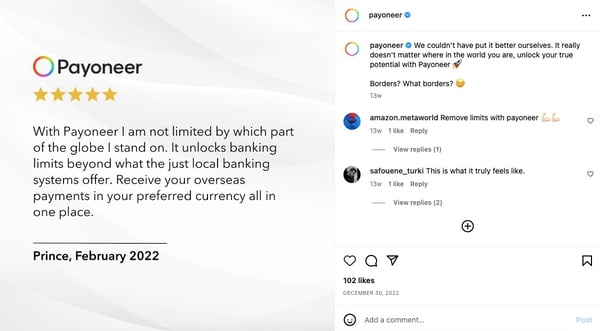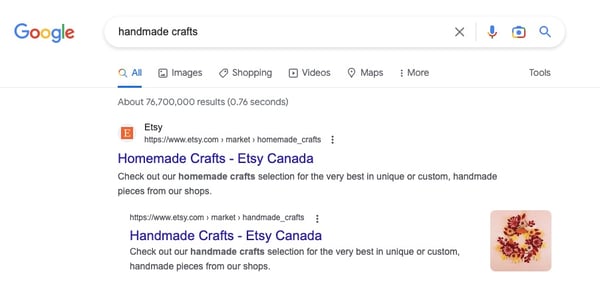
Everywhere you look, there’s this pressure to produce high-quality content online, but… why? In today’s digital world, content marketing has become a crucial aspect of every ecommerce business. It’s a super powerful tool that helps businesses reach out to their target audience and engage with them through relevant and valuable content.
In this article, we’ll offer you tips on how to create a well-planned content marketing strategy so that you can improve your online presence, build brand awareness and generate more leads and sales.
Content marketing strategy: table of contents
- What is content marketing?
- Why is content marketing important?
- Types of content for your strategy
- Content marketing examples
- How to create your own content marketing strategy
- Content marketing strategy: summary
What is content marketing?
Content marketing is a strategic approach that involves creating and sharing valuable, relevant content in a consistent way, all to attract and retain a clearly defined audience. The primary goal of content marketing is to provide information and solutions that meet the needs of the target audience, without explicitly promoting a brand or product.
Content marketing can take many forms, including blog posts, videos, infographics, ebooks, white papers, social media posts, webinars and podcasts. The key is to create content that aligns with the interests and preferences of the target audience, and to distribute it through various channels where they are most likely to consume it.
Check out an example from Shoplazza's Instagram account:
Why is content marketing important?
Now that we’ve answered the question, “What is content marketing?”, let’s have a look at the main reasons you should implement a content marketing strategy in your business right now.
Build brand awareness
People won’t hear about your brand through your products alone. Content marketing allows your business to create content that educates, entertains and informs your target audience. This kind of content has a higher chance of reaching your potential customers, even before they actually need your product or service.
Suppose you own a small business that sells cosmetics and natural skincare products. To build brand awareness, you could create a blog post about the benefits of using natural ingredients in skincare products. You could also create social media posts that showcase the natural ingredients you use in your products and how they benefit the skin.
By consistently creating content that educates and informs your target audience about the benefits of natural skincare, you can establish yourself as an industry expert. This can help you attract potential customers who are interested in your products and are looking for natural alternatives to traditional skincare products.
Here’s what The Body Shop posted recently on their Instagram as an example of building authority and brand awareness with content:
Over time, as you continue to create valuable content, your brand will become more recognizable, and your audience will begin to associate your brand with natural and effective skincare. This can lead to increased brand awareness, which can drive more traffic to your website and ultimately result in more sales.
Establish trust
In addition to building brand awareness, content marketing can also help businesses to establish trust with their audience.
Now let’s imagine you own a store that sells plants online, and you want to establish trust with your target audience. You could create a blog post about the benefits of indoor plants, including how they improve air quality, reduce stress and boost productivity.
If you create content that educates your audience about the benefits of indoor plants, you can demonstrate your expertise in the field, build credibility and establish yourself as a trustworthy source of information. This will be valuable in fostering trust with your audience and can ultimately lead to increased loyalty and repeat business.
Additionally, you can use customer testimonials and reviews from satisfied customers to demonstrate social proof and show that your plant store is a reliable and trustworthy business.

Payoneer doesn’t sell plants, but they do share feedback from customers on their Instagram account as part of their content marketing strategy.
You might have heard of user-generated content (or UGC if you’re into acronyms), which refers to content created by customers or users of your product/service. This strategy involves encouraging customers to share their experiences using your products or services on social media platforms. Customers tend to trust other customers way more than brands, so UGC is an effective content marketing strategy to provide social proof of your product’s value and build your brand image as a trustworthy business.
Generate leads
Another benefit of content marketing is: It can help businesses boost store traffic and generate leads.
If you sell jewelry online, for instance, you could create a blog post about the latest jewelry trends, including unique designs that are popular among millennials and Gen Z customers. You can also use this content to showcase your unique designs and highlight the craftsmanship that goes into each piece of jewelry.
To convert these leads into customers, you could include calls-to-action (CTAs) in your content, such as encouraging readers to sign up for your email newsletter or offering a special discount on their first purchase.
When you focus your content marketing efforts on generating leads, you have a considerable chance of attracting potential customers who are genuinely interested in your products or services. And including CTAs in your content will be that extra push to convert these leads into paying customers, increasing your sales and revenue.

Under a highlight called Inside Pandora, Instagram users can get a glimpse into Pandora’s behind-the-scenes, which makes them feel closer to the brand.
Improve search engine rankings
There’s no point in creating an amazing online store if no one can’t find it on Google, right? The thing is, search engines like Google reward businesses that create valuable, high-quality content, which means that investing in a content marketing strategy is your best chance of ranking well in organic searches.
Suppose you are an artist who sells handmade crafts online, and you want to increase your ecommerce’s visibility in search engine results pages (SERPs). One way to do this is by creating blog posts or other types of content that use relevant keywords and provide valuable information to your target audience.
For example, you could create a blog post about the benefits of buying handmade crafts, including the personal touch and attention to detail that goes into each item. In this post, you’d need to implement an SEO strategy and use keywords such as “handmade crafts,” “unique gifts,” and “artisanal products” to help search engines understand what your content is about.

Notice how Esty has a page within their website called Handmade Crafts, which makes it easier for their website to rank well on Google search results for this keyword.
By creating high-quality, informative content that uses relevant keywords, you can improve your website’s search engine rankings and attract more traffic to your site. This can help to increase your visibility and drive more sales of your handmade crafts.
Another way to improve your search engine rankings through content marketing is by creating backlinks to your website. Backlinks are links from other websites that lead back to your site, and they are an important factor in search engine algorithms.
To create backlinks, you could reach out to other bloggers or websites in your niche and offer to guest post on their site. In your guest post, include a link back to your own website, which can help to improve your search engine rankings and drive more traffic to your site.
🔎 Speaking of SEO, here are some materials you can use to boost your organic search strategy:
Provide value to your customers
Having a content marketing strategy also allows your business to provide value to your audience―which makes customers appreciate you.
Here’s what we mean by providing value: Let’s say you sell enamel pins online. Some people might think, They’re just pins, how can I offer any value based on that?
Enamel pins have become a popular accessory among young people, and there are many stores that sell them online. To stand out from the competition and provide value to customers, your enamel pin store could create content that showcases the unique designs and cultural references behind each pin.
For example, your store could create a social media post that highlights the history and significance of a particular pin design. You could explain the cultural references behind the design, such as the use of symbols or imagery from a particular subculture or fandom. And you could also showcase the level of detail and craftsmanship that goes into each pin, explaining how they are made and the materials used.
By providing this type of value-added content, your store can differentiate itself from other enamel pin sellers who simply offer basic product listings. This type of content can also help you build a community of customers who share a passion for the same subculture or fandom.
In addition, you could use your content marketing efforts to provide helpful tips and advice to customers―for example, by creating a video tutorial on how to display and organize enamel pins, or on how to incorporate enamel pins into different outfits or accessories.
See the many possibilities you have for providing value to your audience? By doing so, your store can build a loyal following of customers who appreciate your unique products or services and the helpful advice you provide. Implementing a content marketing strategy lets you position your brand as helpful and customer-centric, which can foster customer loyalty and increase the lifetime value of your customers.
🤩 Help your customers see value in your products by writing the perfect product descriptions.
Save money
Compared to traditional advertising methods, content marketing is relatively inexpensive. With in-house content creation, your online store can save money on advertising costs while still reaching your target audience.
A good content marketing strategy can do wonders for a new brand as it’s cost-effective and can drive high levels of ROI.
Additionally, content marketing has a longer shelf life than traditional advertising methods, meaning that businesses can continue to generate leads and attract customers long after the content has been created.
Types of content for your content marketing strategies
Now that we’ve convinced you of the importance of a content marketing strategy (we think), let’s delve into the main types of content you can invest in to help you with your content creation process.
Blog posts
When it comes to content marketing strategies, it’s hard to beat blog posts. They’re one of the most popular content formats and can cover a variety of topics related to your niche, product or service, all while educating your audience and establishing your brand as an authority in your industry.
If you decide to start a blog, you’ll be able to provide value to your audience, establish thought leadership and improve their search engine rankings. You can also use your blog to address common pain points of your target audience, showcase your products or services, or share your company culture.
Here are some format ideas for your blog posts:
- How-to articles: Provide step-by-step instructions on how to use your products or services, or how to solve a common problem related to your industry. Check out How to Sell on Amazon in 2023: A Step-by-Step Guide as an example.
- Listicles: Create a list of tips, best practices or resources related to your industry or niche. For example, we wrote a listicle with 20 Ways to Make Money from Home in Canada.
- Case studies: Share real-life examples of how your products or services have helped your customers overcome challenges and achieve their goals. Check out this case study we wrote for Creality and their Shoplazza online store.
- Industry news and trends: Share updates and insights on the latest news, trends and changes happening in your industry. If you want an example, we wrote this blog post on social commerce trends recently.
- Product reviews: Provide detailed reviews of your products or services, highlighting their features, benefits and use cases. For instance, we wrote a blog post to showcase Shoplazza’s SEO features.
- Q&A sessions: Answer common questions from your customers or audience related to your industry or niche, like this affiliate marketing FAQ we created.
- Behind-the-scenes: Share BTS stories (not to be confused with the K-Pop group) and insights into your company culture, team or processes. For example, we wrote this piece on how Shoplazza deals with review website bias.
- Seasonal content: Create content related to holidays, special occasions or current events that are relevant to your industry or niche.

Shoplazza has a blog (this one!) where website visitors can learn more about all things ecommerce and get to know our platform as well.
Social media posts
Nowadays, it’s kind of impossible to build a successful content marketing strategy without social media. With billions of users across various platforms, a social media strategy provides businesses with a valuable opportunity to reach and engage with their target audience.
Social media posts can include images, videos and written content that provide value to your audience and help build your brand’s online presence. Your social media posts can also be used to promote your other content marketing efforts, such as blog posts, videos and ebooks.
Here are some tips on how to use social media in your content marketing strategy:
- Choose the right social media platforms: Not all social media platforms are created equal, and different platforms have different audiences, features and best practices. Depending on your industry and target audience, you may want to focus on a different platform. Choose the ones that align with your content marketing goals and audience preferences.
- Create a content calendar: If you want to nail your social media marketing, you need consistency. Create a content calendar that outlines the types of content you will be posting, the frequency of your posts and the timing of your posts. A content calendar will help you stay organized and ensure that you're providing your audience with a steady stream of valuable content.
- Use visuals: Social media are highly visual, no matter which platform you’re on. Incorporating images and videos into your content can help your posts stand out and drive engagement. Use high-quality, enhanced photos and visuals that align with your branding and messaging.
- Engage with your audience: Social media is a two-way conversation, so make sure you’re (a) creating engaging content and (b) actually engaging with your audience. Respond to comments, ask questions and encourage feedback to build relationships and foster a sense of community around your brand.
By following these tips, businesses can leverage the power of social media to increase brand awareness, drive engagement, and ultimately achieve their content marketing goals.
👥 Step up your social media game with these resources:
- How to Write the Perfect Instagram Bio to Attract Followers
- How to Use Instagram Hashtags for Likes and Traffic
- Like and Subscribe: How To Make Money on YouTube
Videos
Videos are an incredibly powerful tool in a content marketing strategy, providing businesses with an engaging and memorable way to connect with their audience. They’re in a separate category from social media because, well, social media isn’t the only place where you can share them; you post them pretty much on any website on the internet, including yours.
Videos are a highly engaging form of content marketing that can help educate, entertain and inspire your audience. Video content can include product demonstrations, tutorials, brand stories and more.
Here are some tips on how to include video marketing in your content strategy:
- Identify your goal: Before you start creating videos, it’s important to identify your goals. What message do you want to convey? Are you trying to educate, entertain or inspire your audience? By identifying your goal, you can create videos that align with your overall content strategy and messaging.
- Choose your format: There are many different formats for video content, including explainer videos, how-to videos, product demos, interviews and testimonials. Choose the format that best aligns with your goal and the preferences of your audience.
- Keep it short and sweet: Attention spans are short, so it’s important to keep your videos concise and to the point. That is not to say you can only create 1-minute videos. What we’re saying is that you should check if every little bit of the video is essential before posting it.
- Use visuals and audio to your advantage: Videos are a highly visual and auditory medium, so make sure you're using high-quality visuals and audio to convey your message. Use engaging graphics, animations and music to make your videos more compelling and memorable.
- Optimize for SEO: Just like other forms of content, videos can be optimized for search engines to increase your online visibility and reach. Use keyword-rich URLs, titles, descriptions and tags, and include transcripts or closed captions to make your videos more discoverable through organic search and accessible to a wider audience.
 Part of our content marketing strategy is to post videos on the Shoplazza YouTube channel.
Part of our content marketing strategy is to post videos on the Shoplazza YouTube channel.
Infographics
Infographics are an incredible visual content format that you can use to communicate complex information in a simple and engaging way. They consist of visual representations of data, statistics and other info that help to simplify intricate topics, making them more digestible for your audience.
Here are some tips for you to include infographics in your content marketing strategy:
- Choose the right topic: Infographics work best when they’re focused on a specific topic or theme that is relevant to your business and your audience. Choose a topic that is interesting, informative and visually appealing—and that aligns with your overall content strategy.
- Gather data and information: The key to a successful infographic is to have compelling data and information to share. Do your research to gather statistics, facts and figures that support your message and help tell your story.
- Design for clarity and simplicity: Infographics should be designed with clarity and simplicity in mind. Use clear and easy-to-read fonts, color schemes that are consistent with your brand, and simple graphics and illustrations that enhance the message of the infographic.
- Tell a story: The best infographics tell a story that engages the reader and communicates a clear message. Use a narrative structure to guide the reader through the information and help them understand the key takeaways.
- Optimize for sharing: Infographics are highly shareable, so it’s important to optimize them for social media and other digital channels. Use formats that are easy to share and embed, and include social sharing buttons to encourage others to share your infographic.
- Promote your infographic: Once you've created your infographic, it’s important to promote it to reach a wider audience. Share it on social media, include it in email marketing campaigns, and reach out to influencers or other websites in your industry to see if they will share your infographic with their audience.
Incorporating infographics into your content strategy is a great way to drive brand awareness, organic traffic, engagement and conversions.
Ebooks
Ebooks are longer-form content marketing assets that provide in-depth information on a specific topic related to your industry or product. You can use ebooks to educate your audience, establish your brand as a thought leader in your niche and generate leads.
Before you jump into your ebook content creation, you should choose a topic that addresses your audience’s needs and interests. Your ebook should provide valuable information, insights or solutions that your audience can use.
It goes without saying that your ebook should be well-written, informative and engaging. Use visuals, case studies and examples to illustrate your points and make your ebook more interesting to read.
The design of your ebook is just as important as the content production. Use a layout that is easy to read and visually appealing, and make sure to use clear and easy-to-read fonts.
Once your ebook is complete, it’s important to promote your ebook to your target audience. Share it on your website, social media channels and email marketing campaigns.
One of the best uses for ebooks, however, is turning them into lead magnets. By offering your ebook as a free download in exchange for an email address, you can capture your audience’s contact information to nurture leads and convert them into customers.
💻 Interested in ebooks and digital stuff? Check out the top 7 digital products to sell online in 2023.
Newsletters
Newsletters are a valuable component of a content marketing strategy, providing businesses with a way to regularly communicate with their audience and share relevant content. A lot of companies build newsletters as part of their email marketing strategy, but very few actually tap into all the potential they have to offer.
By using newsletters in a content strategy, your business can build a loyal following, establish thought leadership, drive traffic to your store and boost sales. Newsletters are a powerful tool for staying top-of-mind with current and potential customers, and they can help build trust and credibility over time.

Wealthsimple created a newsletter to share news about the market and anything that might interest their potential and existing customers.
Here are our main tips on how to use newsletters in your content marketing strategy:
- Use a clear call-to-action (CTA): Include a clear CTA in your newsletter that encourages your audience to take action, such as visiting your website or making a purchase.
- Be consistent: To build a loyal following, it’s important to be consistent with your newsletter. Set a regular schedule for sending out newsletters, such as weekly or monthly.
- Personalize your newsletter: Personalization can help make your newsletter more relevant and engaging to your audience. Use data such as their name, interests and past behavior to personalize your newsletter content.
- Analyze your results: Use analytics tools to track the performance of your newsletter, such as open rates, click-through rates and conversions. Use this data to create even more awesome and optimized content so as to improve your results over time.
Webinars
Webinars can really boost your content marketing strategy, as they create an opportunity to educate and engage your audience in a live, interactive format.
Hosting webinars is a great way to educate your audience on a specific topic related to your product or service. This strategy involves creating an engaging presentation, inviting industry experts or guest speakers, and promoting the webinar to your target audience.
Webinars are effective because they can help establish your business as a thought leader in your industry, provide value to your audience and bring in more organic traffic.
You can either organize events on platforms like Zoom and Google Meets, or you can go live on TikTok or any other social media that boasts live streaming features.
Here’s a little step-by-step to successfully include webinars in your content strategy:
- Choose a topic that is relevant and valuable to your audience, and aligns with your business goals, like a product demonstration, a thought leadership presentation, a Q&A session, etc.
- Promote your webinar through social media, email marketing and other channels to encourage sign-ups. Use a landing page to collect registrations and communicate the details of the webinar.
- Create engaging content, which can include slides, videos, interactive polls, and Q&A sessions. Visuals such as images, graphics and videos can make your webinar more engaging and appealing to your audience.
- Practice and rehearse your webinar to ensure that it runs smoothly and without technical glitches. This will help you feel more confident and prepared on the day of the webinar.
- Follow up after the webinar. Use email marketing and other channels to follow up with attendees after the webinar, providing them with additional resources or next steps.
- Use analytics tools to monitor the performance of your webinar, such as attendance rates, engagement metrics and conversions. This data can help you optimize your webinar content and improve your results over time.
📹 Shoplazza’s also into webinars! Watch our webinar on how you can build a social commerce brand from the ground up:
Podcasts
Podcasts are a growing content marketing trend that can help you reach a new audience and provide valuable information to your existing one.

This content strategy involves creating a regular podcast series that discusses topics related to your industry, product or service. Podcasts are super effective because they can help you establish your brand as an authority in your industry, and are often a more convenient way for your audience to consume information.
Here are some tips for your podcasts to become a huge hit and boost your content strategy:
- Invest in quality equipment and production to ensure that your podcast sounds professional and engaging. This can include a high-quality microphone, editing software and a dedicated recording space.
- Promote your podcast with the help of social media, email marketing and other channels. Use a landing page or your own site to showcase your podcast and provide additional resources to encourage listens and subscriptions.
- Publish on a consistent schedule, such as weekly or bi-weekly, to build a loyal audience and establish trust and credibility.
- Use guest speakers and interviews to offer fresh perspectives and insights, and to broaden your audience.
- Provide additional resources and links in each episode, such as blog posts and white papers, so your audience can get even more value out of your content.
Content marketing examples
Now that you’ve got a pretty good idea of the different types of content you can use, shall we go over a few examples of real companies implementing their own content marketing strategies?
Radical content creation: Red Bull
Red Bull is an incredible example of a brand that has successfully leveraged content marketing to build a loyal following. The company creates high-quality content that aligns with their target audience’s interests and passions, such as extreme sports and music, all while conveying their brand identity.
Red Bull’s content marketing has helped to establish it as a lifestyle brand, rather than just a beverage company. By associating its brand with extreme sports and other activities, Red Bull has created a strong emotional connection with its audience, which has helped to drive brand loyalty and sales.
Their content strategy is also successful because it’s super shareable and engaging. Their videos, in particular, are visually stunning and highly entertaining, making them highly shareable on social media and other platforms—so much so that we’re sharing one of them here:
Overall, Red Bull is a great example of how a company can use a strong brand identity and engaging content to build a loyal audience and drive business results.
Patagonia
Another example of a company that is using a successful content marketing strategy is Patagonia, an outdoor clothing company that produces high-quality, sustainable clothing for outdoor enthusiasts.
Patagonia’s content marketing strategy focuses on environmental sustainability and ethical production practices. The company produces a wide range of content, including blog posts, videos and social media posts, that highlight the importance of environmental conservation and ethical production.
Patagonia’s content strategy is effective because it aligns with the company’s brand identity and mission statement, which is to “Protect our home planet.” This kind of commitment resonates with their target audience. By focusing on environmental sustainability and ethical production, Patagonia has created a strong emotional connection with their audience, which has helped to drive brand loyalty and sales.
🌎 Protect the environment and make some sales while you’re at it. Find out how green marketing can help your business (and the planet) thrive.
How to create your own content marketing strategy
Now that we understand the importance of content marketing and have seen some successful examples, let's explore how to create a content marketing strategy for your ecommerce business.
1. Define your target audience
The first step in creating a content marketing strategy is to define your target audience. You need to have a clear understanding of who your ideal customers are, what their pain points and interests are, and how they prefer to consume content.
If you have done market research for your business, you can definitely use the information you gathered to define who to focus on in your content efforts.
To define your target audience, you can use buyer personas, which are fictional representations of your ideal customers. These personas should include demographic information, such as age, gender and location, as well as psychographic information, such as interests, behaviors and values.
🎯 For more insights into your niche and target audience, consider running a competitive analysis.
2. Set your content marketing goals
Once you have a clear understanding of your target audience, the next step is to define your content marketing goals. These goals should align with your overall business objectives and should be specific, measurable, achievable, relevant and time-bound (SMART).
Some common content marketing goals for ecommerce businesses include:
- Increasing website traffic
- Generating leads and sales
- Increasing brand awareness
- Boosting engagement and social media followers
- Establishing thought leadership in your industry
3. Conduct a content audit
Before you start creating new content, you should definitely run an audit of your existing content. This audit should include a review of your website content, blog posts, social media posts, email campaigns and any other content you have produced.
The purpose of a content audit is to identify gaps and opportunities in your content marketing strategy and to determine what types of content resonate best with your target audience.
Which formats bring in more website traffic? Which topics generate more engagement? Your audit should be able to yield answers to these and any other questions you might have about the effectiveness of your content strategy.
You can use tools like Google Analytics and social media analytics to track your content’s performance and identify areas for improvement.
🚦 Organic content isn't the only way to draw more visitors to your store. Find out what paid traffic is and what are the best paid traffic sources for your business.
4. Develop a content plan
Based on your target audience, content goals and audit, you can create a content marketing plan that outlines what you will create, how often you will publish and where you will distribute content.
By this point, you should have enough info to begin brainstorming some content ideas. Consider the different formats and types of content that will resonate with your audience.
This is also when you develop a content calendar to plan your content in advance. Having a calendar will help you manage content creation and ensure that you are publishing stuff consistently. Consider seasonal events, holidays and other important dates when planning your content calendar.
Another important task to tick off your list is to determine who will be responsible for content production and publishing: Is it an in-house team, an agency or freelance content marketers? Once you have that figured out, make sure that everyone knows their roles and responsibilities.

5. Create and distribute your content
Once you have a content plan in place, the next step is to create and distribute your content. You should create a variety of content formats, such as blog posts, videos, infographics and social media posts, to appeal to different audience segments.
When creating content, keep in mind your target audience’s pain points, interests and preferences. Your content should be super engaging, informative and relevant to your audience's needs. You should also optimize your content for search engines by adding relevant keywords and meta descriptions.
Once your content is created, it’s essential to distribute it through various channels to reach your target audience. You can use social media platforms, email campaigns, influencer marketing and paid advertising to distribute your content and attract more visitors to your ecommerce website.
6. Track and measure the results of your content marketing efforts
The final step in creating a content marketing strategy is to monitor and measure your results. You should track your content’s performance using analytics tools, such as Google Analytics, social media analytics and email marketing metrics.
By monitoring your content’s performance, you can identify which types of content are resonating best with your target audience and adjust your content plan accordingly. You can also measure the impact of your content marketing on your overall business objectives, such as website traffic, leads and sales.
Content marketing strategy: summary
In conclusion, content marketing strategy is a powerful tool that can help ecommerce businesses like yours reach their target audience, build brand awareness and generate more leads and sales. By following the steps outlined in this guide, you can create a content strategy that aligns with your business goals and resonates with your target audience.
Just to recap, remember to define your target audience, set goals for your content efforts, conduct a content audit, develop a content plan, create and distribute your content, and monitor and measure your results. With a well-planned content marketing strategy, you can position your ecommerce business as an authority in your niche and interact with your target audience in a meaningful way.
Keep in mind that creating a successful content marketing strategy takes time, effort and resources. It’s important to remain patient and persistent in your efforts and continuously evaluate your results to make informed decisions and adjust your own strategy accordingly.
Content marketers everywhere might be biased, but they’ll tell you that having a content strategy is a key component of any successful ecommerce business. When you create and distribute valuable, relevant and compelling content to your target audience, you can attract more website visitors, build brand awareness and meet your business goals. So, what are you waiting for? Get your creative juices flowing, start crafting your content marketing strategy today and watch your ecommerce business thrive!


